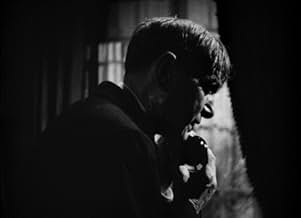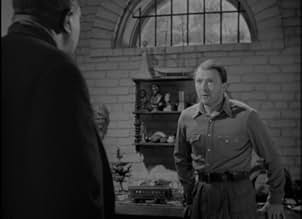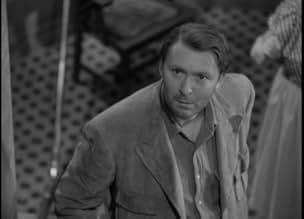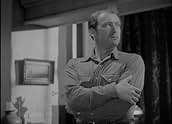अपनी भाषा में प्लॉट जोड़ेंA mentally unstable man who has been kept in isolation for years escapes and causes trouble for his identical twin brother.A mentally unstable man who has been kept in isolation for years escapes and causes trouble for his identical twin brother.A mentally unstable man who has been kept in isolation for years escapes and causes trouble for his identical twin brother.
Jane Allen
- Jitterbug Dancer
- (बिना क्रेडिट के)
Rod Cameron
- Eddie - Man in Cafe
- (बिना क्रेडिट के)
Eddy Chandler
- Motorcycle Cop
- (बिना क्रेडिट के)
Lane Chandler
- Neighbor
- (बिना क्रेडिट के)
Catherine Craig
- Second Mill Girl
- (बिना क्रेडिट के)
फ़ीचर्ड समीक्षाएं
Just what sort of movie is Among the Living? It's not that easy to determine. This short (67 minute) 1941 offering is part thirties gothic and part early noir; in any case it's fairly primitive but it has its moments. Albert Dekker (his screen debut) plays twin brothers, one of whom, presumed dead for a quarter-century, is an infantile psychotic. He's been sequestered away in the decrepit family pile all these years but manages to escape, taking up residence in a rooming house owned by the young Susan Hayward's mother. When it looks like the gibbering idiot has money to burn, Hayward sets her hat for him. The most interesting facet of the film is watching Susan Hayward play her speciality, an on-screen hellion, particularly since Frances Farmer, gets wasted as the proper and dutiful wife of the "good" Albert Dekker. Much mayhem ensues, revolving around the confusion between the brothers (the existence of one of whom, remember, has been a deep dark secret). Toward the end, the film develops an ugly energy as the townspeople coalesce into a lynch mob, but, beware: this is not Fritz Lang's Fury. By modern standards, Among the Living has become a curio.
Although Among The Living is a B film from Paramount it's a real nugget of gold among a lot of B dross. You will rarely see mob violence depicted as well as in this film. Two films that this stands comparison with in that regard are Fury and Night Of The Hunter.
It's also a great example of the mobility of careers. Frances Farmer whose career was heading down is in a relatively colorless part of the wife of one Albert Dekker. Susan Hayward plays the slutty daughter of a boardinghouse owner who gets involved with the other twin Dekker. She's got the far juicier role and makes the most of it.
Once upon a time a man had two twin sons both of whom grew up to be Albert Dekker. As is told by the town doctor Harry Carey, one was sent to a prep school, the other stayed at home. By all accounts dad was a tyrant at home and at work where he owned the mill that employed most of the town. The twin that stayed at home witnessed dad beating on mom and tried to stop it. Dad picked him and threw him against a wall injuring his brain.
Rather than risk exposure dad had his friend Harry Carey fake a death certificate and they kept the kid in a locked room. Now father is dead and the kid who has grown up to be Albert Dekker is a now quite unhinged and murders a family servant to escape.
And while out murders a woman that the town blames his brother for. Quite a dilemma for the sane Dekker and wife Farmer.
Hayward gives a good account of herself, but the film really belongs to Albert Dekker. This is quite possibly his career film, even more so than Dr. Cyclops. Especially playing the mad son, you really do feel for him knowing it's not his fault the way he is.
With a good does of both noir and Gothic horror, I highly recommend this film for fans of both genres. And definitely for fans of Susan Hayward as I am.
It's also a great example of the mobility of careers. Frances Farmer whose career was heading down is in a relatively colorless part of the wife of one Albert Dekker. Susan Hayward plays the slutty daughter of a boardinghouse owner who gets involved with the other twin Dekker. She's got the far juicier role and makes the most of it.
Once upon a time a man had two twin sons both of whom grew up to be Albert Dekker. As is told by the town doctor Harry Carey, one was sent to a prep school, the other stayed at home. By all accounts dad was a tyrant at home and at work where he owned the mill that employed most of the town. The twin that stayed at home witnessed dad beating on mom and tried to stop it. Dad picked him and threw him against a wall injuring his brain.
Rather than risk exposure dad had his friend Harry Carey fake a death certificate and they kept the kid in a locked room. Now father is dead and the kid who has grown up to be Albert Dekker is a now quite unhinged and murders a family servant to escape.
And while out murders a woman that the town blames his brother for. Quite a dilemma for the sane Dekker and wife Farmer.
Hayward gives a good account of herself, but the film really belongs to Albert Dekker. This is quite possibly his career film, even more so than Dr. Cyclops. Especially playing the mad son, you really do feel for him knowing it's not his fault the way he is.
With a good does of both noir and Gothic horror, I highly recommend this film for fans of both genres. And definitely for fans of Susan Hayward as I am.
Deranged twin brother escapes home confinement after father's death and tries to fit into a new life.
Wacky, highly original horror story. When the luscious Hayward (Millie) makes her entrance at the stairs' top, it's like an explosion of saucy sex appeal. There's enough lively personality there to light up the room. In fact, her gold-digging coquette manages to steal the film. And that's against tough competition from Dekker as the wide-eyed, strangely sympathetic mad strangler. Together, they're easily one of filmdom's genuine odd couples.
Frankly, the story at times makes little sense. But that's okay because it's the characters and Gothic atmosphere that distinguish the film. It's also one of the few films where the camera pans through a hellish mansion, only to focus finally on a guy in a straitjacket (Dekker as the mad Paul), of all things.
Catch that opening scene with the unemployed mill workers taunting the funeral rites for the mill owner. In fact, there's an odd class undercurrent to the screenplay as a whole. Considering that blacklisted leftist Lester Cole did both the story and the script, that's not surprising.
Moreover, the screenplay can be viewed as something of an allegory with mad brother Paul as the brutalized innocent, who would like to side with the workers (he prefers living with them), but has been too damaged by his mill owner father to be able to. In that sense, he suggests Dad's repressed (straitjacketed) humane side hidden away from public view, but finally released by Dad's death into a world his now childlike nature can't comprehend. More tragically, he can only relieve a woman's scream of pain by strangling her, the memory of his abused mother and his attempt to help still fresh in his mind. Dekker's affecting performance with its unexpected degree of pathos underscores, I believe, something of this way of looking at things.
Director Heisler certainly has a flair for exciting crowd scenes. That clip joint with its frenetic swing dancers is a marvel of editing and atmosphere, a really memorable scene. And those teeming street crowds add both color and more atmosphere. The movie's commanding visuals owe a lot to the underrated Heisler. Too bad, however, the talented Frances Farmer is largely wasted in a brief, conventional role.
Anyway, in my little book, the movie's a one-of-a-kind that rises above the ordinary B- feature or horror film, and should not be missed.
Wacky, highly original horror story. When the luscious Hayward (Millie) makes her entrance at the stairs' top, it's like an explosion of saucy sex appeal. There's enough lively personality there to light up the room. In fact, her gold-digging coquette manages to steal the film. And that's against tough competition from Dekker as the wide-eyed, strangely sympathetic mad strangler. Together, they're easily one of filmdom's genuine odd couples.
Frankly, the story at times makes little sense. But that's okay because it's the characters and Gothic atmosphere that distinguish the film. It's also one of the few films where the camera pans through a hellish mansion, only to focus finally on a guy in a straitjacket (Dekker as the mad Paul), of all things.
Catch that opening scene with the unemployed mill workers taunting the funeral rites for the mill owner. In fact, there's an odd class undercurrent to the screenplay as a whole. Considering that blacklisted leftist Lester Cole did both the story and the script, that's not surprising.
Moreover, the screenplay can be viewed as something of an allegory with mad brother Paul as the brutalized innocent, who would like to side with the workers (he prefers living with them), but has been too damaged by his mill owner father to be able to. In that sense, he suggests Dad's repressed (straitjacketed) humane side hidden away from public view, but finally released by Dad's death into a world his now childlike nature can't comprehend. More tragically, he can only relieve a woman's scream of pain by strangling her, the memory of his abused mother and his attempt to help still fresh in his mind. Dekker's affecting performance with its unexpected degree of pathos underscores, I believe, something of this way of looking at things.
Director Heisler certainly has a flair for exciting crowd scenes. That clip joint with its frenetic swing dancers is a marvel of editing and atmosphere, a really memorable scene. And those teeming street crowds add both color and more atmosphere. The movie's commanding visuals owe a lot to the underrated Heisler. Too bad, however, the talented Frances Farmer is largely wasted in a brief, conventional role.
Anyway, in my little book, the movie's a one-of-a-kind that rises above the ordinary B- feature or horror film, and should not be missed.
I’d always been interested in this one – not least because it involves twins (and, thus, reminiscent of the Boris Karloff vehicle THE BLACK ROOM [1935]) – so that when I came across the film, even if I knew that the quality would be far from optimal, I leapt at the chance to acquire it. While not strictly horror, it involves several elements that are part and parcel of the genre – old dark house, family secret, madness, murder, mob fury, etc.
Despite, as I said, the fact that the video was rather fuzzy – so that the images generally lacked detail – I was nonetheless struck by the film’s cinematography and editing: these were particularly effective during a scene at a bar, where the mad brother (who had been secluded all his life but has now broken loose) is ridiculed by the customers, and the one following it where he chases a girl into an alley and kills her. The two central roles are played by Albert Dekker and he does very well by both, though the mad brother is obviously the showier character – which he invests with a remarkable vulnerability (when seeing the locals indulging in a particularly animated jitterbug routine, he naively asks his future victim who’s accompanying him at the time “What are they doing?”); incidentally, despite the narrative’s Gothic – or, more precisely, Southern – trappings, the setting is a contemporary one.
The supporting cast is a good one and includes: a young Susan Hayward (that is, before she became, the First Lady of Screen Melodrama) as the perky small-town girl who entrances the crazy Dekker – which she’s all-too-willing to play up to, but who promptly and fiercely turns against him when he’s eventually revealed to be the cause of the terror which has gripped the community!; Harry Carey in the ambivalent role of the town doctor who, having been complicit in the cover-up of the mad brother’s existence, fears the repercussions of this act if he were to intervene when – at the satisfactorily frenzied climax – the good Dekker is accused of his brother’s crimes!; and the troubled Frances Farmer who, however, is wasted in the colorless role of the innocent sibling’s wife (in a virtual prerequisite of genre heroines, the actress is also asked to scream – which she does unconvincingly! – in her one scene with the mad Dekker).
The film is a Paramount production and, therefore, currently owned by Universal; while the latter have served their horror back-catalogue reasonably well on DVD, the equivalent stuff from that other studio has been consistently (and bafflingly) neglected over the years – especially since this includes such highly-desirable titles as ISLAND OF LOST SOULS (1932), MURDERS IN THE ZOO (1933) and, now, AMONG THE LIVING itself...
Despite, as I said, the fact that the video was rather fuzzy – so that the images generally lacked detail – I was nonetheless struck by the film’s cinematography and editing: these were particularly effective during a scene at a bar, where the mad brother (who had been secluded all his life but has now broken loose) is ridiculed by the customers, and the one following it where he chases a girl into an alley and kills her. The two central roles are played by Albert Dekker and he does very well by both, though the mad brother is obviously the showier character – which he invests with a remarkable vulnerability (when seeing the locals indulging in a particularly animated jitterbug routine, he naively asks his future victim who’s accompanying him at the time “What are they doing?”); incidentally, despite the narrative’s Gothic – or, more precisely, Southern – trappings, the setting is a contemporary one.
The supporting cast is a good one and includes: a young Susan Hayward (that is, before she became, the First Lady of Screen Melodrama) as the perky small-town girl who entrances the crazy Dekker – which she’s all-too-willing to play up to, but who promptly and fiercely turns against him when he’s eventually revealed to be the cause of the terror which has gripped the community!; Harry Carey in the ambivalent role of the town doctor who, having been complicit in the cover-up of the mad brother’s existence, fears the repercussions of this act if he were to intervene when – at the satisfactorily frenzied climax – the good Dekker is accused of his brother’s crimes!; and the troubled Frances Farmer who, however, is wasted in the colorless role of the innocent sibling’s wife (in a virtual prerequisite of genre heroines, the actress is also asked to scream – which she does unconvincingly! – in her one scene with the mad Dekker).
The film is a Paramount production and, therefore, currently owned by Universal; while the latter have served their horror back-catalogue reasonably well on DVD, the equivalent stuff from that other studio has been consistently (and bafflingly) neglected over the years – especially since this includes such highly-desirable titles as ISLAND OF LOST SOULS (1932), MURDERS IN THE ZOO (1933) and, now, AMONG THE LIVING itself...
'Among the Living (1941)' sits in the middle-ground between film noir and horror. The horror elements are obvious: the use of twins, representing the duality of man, recalls a more literal take on the themes of Stevenson's "Dr Jekyll and Mr Hyde." But even the "evil" twin himself is not a monster, as he is often described. Like Frankenstein's Creature, he is merely a social outcast, corrupted by the abuse of the true monsters, and who ultimately finds it impossible to assimilate into society. Like a frightened animal, Paul Raden struggles to understand the violent, cynical world in which he's been thrust, and the injustices knowingly done to him, combined with the years of abuse he endured at the hands of a dominating father, lead him to murder out of sheer terror. In many ways, Paul resembles the character of Lennie in Steinbeck's "Of Mice and Men," a simpleton with a brutish strength that he can't reconcile with his own child-like desires.
Though one would stop short of calling this a film noir, there are certainly traces of the necessary elements. Most prominent is the theme of hidden family secrets, of a shameful past coming back to haunt wrongdoers, as in 'The Strange Love of Martha Ivers (1946).' The corruptive influence of power is also referenced – as in the latter film, the primary sinner of 'Among the Living' (Raden, Sr., who is dead by the film's beginning) resides in a town that bears his name. The viewer can draw two conclusions: either that only through committing sin can a man attain power, or that from power itself is borne the desire to perpetrate crime, for he now has the means to conceal his misconduct. The latter is certainly true for the otherwise-respectable Dr. Saunders (Harry Carey), who – just once – compromised his professional integrity, and, twenty-five years later, finds that this one transgression has blackened his soul and destroyed his future.
John Raden (Albert Dekker) is the film's hapless protagonist, an honest guy who unwillingly stumbles upon his family's dirty secret. Via a succession of ill-fated coincidences, implying the forces of Fate that would later pervade the film noir movement, John finds himself on trial for murder, thrust protestingly into an ad hoc mob trial that recalls Peter Lorre's judgement in 'M (1931).' Dekker is excellent in the dual- roles of John and Paul Raden, with the "bad" half always distinguishable, not just by his grizzled beard and raggedy clothing, but by the way he carries himself: slouched shoulders, arms held awkwardly, innocent and perplexed eyes upturned at the eccentricities of this unfamiliar society. Susan Hayward plays Millie, a minor femme fatale. She's an angel when you first see her, but the way she knowingly toys with Paul's naivete is quite repulsive, and her nastiness during the courtroom trial is similarly brutal. Notably, director Stuart Heisler would progress onto full-blown noir the following year with the Hammett adaptation 'The Glass Key (1942).'
Though one would stop short of calling this a film noir, there are certainly traces of the necessary elements. Most prominent is the theme of hidden family secrets, of a shameful past coming back to haunt wrongdoers, as in 'The Strange Love of Martha Ivers (1946).' The corruptive influence of power is also referenced – as in the latter film, the primary sinner of 'Among the Living' (Raden, Sr., who is dead by the film's beginning) resides in a town that bears his name. The viewer can draw two conclusions: either that only through committing sin can a man attain power, or that from power itself is borne the desire to perpetrate crime, for he now has the means to conceal his misconduct. The latter is certainly true for the otherwise-respectable Dr. Saunders (Harry Carey), who – just once – compromised his professional integrity, and, twenty-five years later, finds that this one transgression has blackened his soul and destroyed his future.
John Raden (Albert Dekker) is the film's hapless protagonist, an honest guy who unwillingly stumbles upon his family's dirty secret. Via a succession of ill-fated coincidences, implying the forces of Fate that would later pervade the film noir movement, John finds himself on trial for murder, thrust protestingly into an ad hoc mob trial that recalls Peter Lorre's judgement in 'M (1931).' Dekker is excellent in the dual- roles of John and Paul Raden, with the "bad" half always distinguishable, not just by his grizzled beard and raggedy clothing, but by the way he carries himself: slouched shoulders, arms held awkwardly, innocent and perplexed eyes upturned at the eccentricities of this unfamiliar society. Susan Hayward plays Millie, a minor femme fatale. She's an angel when you first see her, but the way she knowingly toys with Paul's naivete is quite repulsive, and her nastiness during the courtroom trial is similarly brutal. Notably, director Stuart Heisler would progress onto full-blown noir the following year with the Hammett adaptation 'The Glass Key (1942).'
क्या आपको पता है
- ट्रिवियाJane Allen's debut.
- भाव
Mrs. Pickens: I had one of them Frenchmen living here last year. Honest to goodness every time you'd turn 'round, that Frenchman was grabbin' your hand and kissing until he'd like to pull the skin off.
टॉप पसंद
रेटिंग देने के लिए साइन-इन करें और वैयक्तिकृत सुझावों के लिए वॉचलिस्ट करें
- How long is Among the Living?Alexa द्वारा संचालित
विवरण
- चलने की अवधि1 घंटा 7 मिनट
- रंग
- ध्वनि मिश्रण
- पक्ष अनुपात
- 1.37 : 1
इस पेज में योगदान दें
किसी बदलाव का सुझाव दें या अनुपलब्ध कॉन्टेंट जोड़ें




































